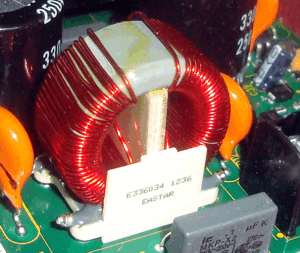What is an Induction or Switching Power Supply Transformer?
A Switching Mode Power Supply Transformer, like a Flyback Transformer, automobile Ignition Transformer, or Line Output Transformer (LOPT), uses magnetism generated with its primary winging to generate electrical power in its secondary winding.
Fire Alarm System Switching Mode Power Supply Transformer uses Flyback Transformer Principles to provide high current using a small iron/ceramic core.
By Douglas Krantz
In the United States they're called Flyback Transformers; in other countries they're called Line Output Transformers (LOPT). Even automobile ignition coils use the principles of a Flyback Transformer to transfer power from the primary side to the secondary.
What makes the Flyback Transformer unique?
Brief History of the Flyback Transformer
-
1831 -- Michael Faraday is generally credited with figuring out about electromagnetism and some factors involving transformer action
-
1836 -- Nicholas Callan experimented with an induction transformer, which is basically a Flyback Transformer
-
1910 -- Charles Kettering came out with an ignition coil for creating sparks in internal combustion engines
-
Late 1940s -- the television Flyback Transformer, or LOPT, was developed
-
Late 20th Century -- Switching Mode Power Supplies started using transformers with the Flyback Transformer principles
The Induction Transformer, the car Ignition coil, the television Flyback Transformer, and the
Switching Mode Power Supply LOPT all have one thing in common: they all use the kick produced by the collapsing magnetic field in the core to apply a short term, high power pulse to the output coil of the transformer.
Power Supply Transformer
A transformer is just a power transfer device; it transfers power from the input or primary windings, to the output or secondary windings. It uses magnetism as the method of coupling the two windings together. Almost all of the power applied to the input shows up at the output.
The difference between a general purpose transformer and a Flyback Transformer is that the general transformer and its associated circuitry transfers energy from input to output on a pretty much continuous basis, while the Flyback Transformer and its associated circuitry compress this transfer of energy so it comes out in short high power bursts.
Transformer Theory
There are two significant windings to transformers. The energy goes in on the primary winding and comes out on the secondary winding. Magnetism transfers the energy from one coil to the other, with the primary winding and core as an electromagnet, and the same core and secondary winding as a generator.
Pulse Driven
Rather than the continuously changing voltage supplied to most general purpose transformers, the Ignition Coil, the Flyback Transformer, and the LOPT have their applied voltage switched on and off repeatedly.
Magnetism, here, is used as a storage medium for the energy.
The turning on of the voltage causes electrical current in the primary coil to build up the magnetic field in the core of the transformer. With each cycle, once the magnetism is built up in the core, the voltage is turned off, stopping the current. At this point, the magnetic field in the core starts collapsing.
Pulse Given
Using this powerful collapse of the magnetic field, the secondary coil is becomes a generator, producing a short term high power pulse. The Flyback Transformer and Ignition Coil have many turns to their secondary winding to bring about high voltage, while the switching mode LOPT has only a few windings to bring about high current.
In either case, the energy which was applied to the magnetic field during the turn-on portion of the cycle is compressed into a short burst of power in the turn off portion.
Diode action
There is a diode in the output circuit, often called a
Flyback Diode. Its function is the same as a Flyback Diode on a relay, but here, rather than converting the power to wasted heat, the power is used by the rest of the circuit.
The diode conducts these kicks from the collapsing magnetic field into bursts of high voltage for the television set or bursts of high current for switching mode power supplies.
Air Gap
Magnetic cores have a saturation point: the point where they aren't able to build up any more magnetism. When this happens, increasing current in an electromagnet doesn't increase the magnetic field.
Because the magnetic field transfers the power from primary to secondary, a limit on the magnetic field is a limit on the power that is transferred.
Increasing the physical size of the core is one way to increase the power transfer. However, larger cores are heavier and the overall cost of the transformer is higher.
To keep the weight down, what's done in the case of the Flyback Transformer is the magnetic core is given an air gap so the core isn't a complete magnetic circuit. This air gap increases the reluctance (Henrys) of the core and this increased reluctance slows down the reaching of the saturation point of the magnetic core.
In essence, this air gap in the core allows for an increased power transfer from the primary windings to the secondary windings.
The Uniqueness of the Flyback Transformer
Like a general purpose transformer and its associated circuitry, the energy that comes out of the secondary winding of the Flyback Transformer is still close to the energy that goes into the primary winding.
Besides the air gap in the core, the real difference between a general purpose transformer and a Flyback Transformer is the circuitry on the input and output of the transformer.
The input current builds up the magnetic field inside the transformer, and is suddenly cut off. When the current of the input is cut off, the energy that was slowly built up in the magnetic core is suddenly applied to the secondary winding of the transformer.
This sudden surge of energy be used to create a pulse of high voltage or high current.
